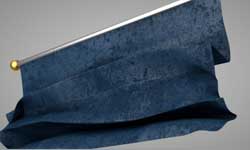CINEMA 4D (658 Tutorials)
Optimizing your scene to render faster in CINEMA 4D – GSG
October 4, 2013
Post by Nick Campbell / Greyscalegorilla. Some great tips on speeding up the render process regardless of machine.
How to optimize your scene to render faster in CINEMA 4D
October 4, 2013
Post by Nick Campbell / Greyscalegorilla: “An expensive new computer may make your renders 2-8X faster. But learn how to optimize your scene, and it can speed up your renders 10-100X. In this video, I show you some ways to optimize your scene in Cinema 4D for faster rendering so you can hit that deadline and still make it look great.”

3D Printing with Cinema 4D and Makerbot
September 19, 2013
3D printing has become more and more popular these days. Thanks to companies like Makerbot you can purchase your own 3D printer small enough to fit on your desk. In this tutorial we'll show you how to model an alien space craft in Cinema 4D then take it into Makerbot's Makerware software to create a 3D print.
This tutorial was created for the awesome team over at thehivecentral.com – Posted by Ryan Boyle
Camera Tracking In AE and C4D – Tracked Ship
August 21, 2013
Chris Martin, Freefxtutorials.com, one of Toolfarm’s affiliates, shows how to motion track footage using After Effects CC’s powerful new camera tracker to get a 3D solution, then send it back to AE for compositing and final render.
Maxon Presentations from SIGGRAPH 2013 – Archives Now Available
August 15, 2013
If you didn’t get a chance to watch the livestream from Siggraph 2013, now’s your chance to catch up on the incredible talent shared during the show.

Cinema 4D Cloth Unroll Effect
August 12, 2013
Post at Motion Squared: “In this short tutorial, we take a look at how to create a cloth unroll effect /animation using the cloth dynamics tag in Cinema 4D. Enjoy!”
Export 3D Camera Tracking to Cinema 4D
August 6, 2013
“Imagineer Systems Product Manager Martin Brennand takes you through exporting Camera Solve data from mocha Pro and setting it up inside Maxon Cinema 4D.” – Imagineer Systems

Creating a Disco Party Animation with C4D and After Effects
August 6, 2013
“In this tutorial you’ll be creating a full motion graphics 3D animation for a disco party. You’ll start by creating some basic models and deforming them. We’ll dig quite deeply in shading to achieve some detailed and organic textures. Finally, we’ll animate all the elements in an attractive way and create a rotating camera to follow the whole scene. We’ll finish up in After Effects where we’ll add some sexiness to the animation.” – Daniel Lorenzo of cgtuts+
Getting Started with After Effects CC and CINEWARE
July 16, 2013
Mathias Mohl from Mamoworld shows how to create and animate a logo in CINEWARE and finish it in After Effects CC.
Multicam Setup in Cinema 4D and Import Into AE CC
July 16, 2013
By Vic Garcia. Create a Chase Scene in C4D using Multiple Cameras, Stage Object and importing into After Effects CC using the Cineware plugin.
How to create a trampoline in Cinema 4D
July 3, 2013
In this tutorial we will be taking a look at “connect objects” as well as “point selection tags” with in Cinema 4D. These awesome tools will give us the ability to create a trampoline with dynamics.
Hollywood Movie Titles Series – The Great Gatsby
July 3, 2013
We’re going to be looking at the animation style of “The Great Gatsby”. We’ll make this title style using Cinema 4d for the modeling of the logo and After Effects for the final composite. The real core of this tutorial is how to get the logo from a 2d drawing to a complex 3d model. Once you know the secrets of how to get the logo with all its molding, the remaining design of the background come naturally.
Model a Ghostbusters Ghost Trap in Cinema 4D
July 2, 2013
Welcome to Tutorial Tuesday at Toolfarm! How do you catch a ghost in Cinema 4D? You model a Ghostbusters Ghost Trap!
CINEMA 4D Techniques Series (Adobe After Effects CC & CINEMA 4D Lite)
June 27, 2013
Learn how the integration between After Effects and CINEMA 4D benefits you as an artist. Author and 3D expert Chris Martin gives an overview of the workflow.
Add Depth Of Field To Your CINEMA 4D Composite Using Cineware and After Effects
June 27, 2013
In this tutorial, Nick Campbell of Greyscalegorilla shows how to set up a depth pass for rendering depth of field for 3D objects using CINEMA 4D, Frischluft Lens Care and After Effects.